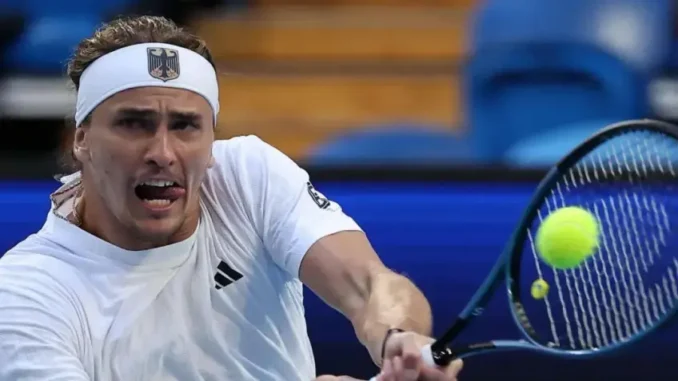
Alexander Zverev, the world No. 3 and a seven-time ATP Masters 1000 champion, stands at a pivotal juncture as he headlines the 2025 National Bank Open in Toronto as the top seed. With a field depleted by the withdrawals of tennis titans like Jannik Sinner, Carlos Alcaraz, and Novak Djokovic, Zverev faces immense pressure to capitalize on this golden opportunity at Sobeys Stadium from July 27 to August 7. His 2017 triumph over Roger Federer in Montreal, a defining moment in his career, looms large as he aims to reclaim the Canadian crown on the hard courts of Toronto. With a stacked resume, a favorable draw, and the weight of expectation, Zverev cannot afford to falter in this expanded 12-day, 96-player tournament, where a deep run could solidify his status as a Grand Slam contender heading into the US Open.
Zverev’s journey to Toronto has been marked by both brilliance and inconsistency. His 2025 season kicked off with a bang, reaching the Australian Open final, only to lose to Sinner in a grueling battle. A title in Munich and a runner-up finish in Stuttgart showcased his prowess, but an early Wimbledon exit to Arthur Rinderknech exposed lingering vulnerabilities. “I’m here to compete, to play, and to try to win,” Zverev echoed sentiments shared by compatriot Felix Auger-Aliassime, signaling his intent to dominate in Toronto. His 2017 National Bank Open victory, a straight-sets masterclass against Federer, remains a high point, one of his seven Masters 1000 titles. Yet, his best Toronto result—a 2018 quarterfinal—suggests untapped potential on this stage. With a first-round bye and an opening match against either Adam Walton or Benjamin Bonzi, Zverev’s path appears manageable, though a potential third-round clash with rising Brazilian star Joao Fonseca, the 18-year-old NextGen Finals champion, looms as an early test.
The withdrawals of Sinner, Alcaraz, Djokovic, and Jack Draper have reshaped the Toronto landscape, elevating Zverev to the top seed and opening the door for a Canadian breakthrough, as noted by tournament director Karl Hale. “We’re in really good shape, still a great player field, and we have great Canadians to mitigate,” Hale said, highlighting the presence of seeded Canadians Felix Auger-Aliassime (No. 24), Denis Shapovalov (No. 25), and Gabriel Diallo (No. 32). For Zverev, the absence of top rivals is a double-edged sword: it reduces the competition but amplifies the pressure to perform. “There’s some disappointment there because we have a 1000 event, which is supposed to come with that guarantee of being able to offer the best players in the world,” Montreal tournament director Valerie Tetreault admitted, acknowledging the challenge of high-profile dropouts. Yet, Zverev’s experience and pedigree make him the man to beat, with a projected quarterfinal against Holger Rune and a potential semifinal clash with Lorenzo Musetti.
Zverev’s hard-court prowess—three Masters 1000 titles, two ATP Finals crowns, and an Olympic gold medal—makes him a natural fit for Toronto’s fast courts. “When on the asphalt, Zverev is a three-time Masters 1000 champion,” a recent analysis noted, underscoring his dominance on the surface. His 35-14 record in 2025, including a recent training block at the Rafa Nadal Academy with Toni Nadal, suggests he’s fine-tuning his game for the North American swing. A fourth-round matchup against Francisco Cerundolo, who holds a 3-0 head-to-head edge, could test Zverev’s resolve, but his recent work on consistency and mental toughness positions him well. “I always say, outside of the Slams, this is the Masters 1000 that I want to win,” Auger-Aliassime said, a sentiment Zverev likely shares given his history in Canada.
The expanded 12-day format, with rest days between matches, offers Zverev a chance to pace himself, a luxury not afforded in previous years when the tournament spanned a week. “The 12 days is bigger, better for the tournament, for the fans, more broadcasts,” Hale emphasized, noting the event’s alignment with marquee Masters 1000 tournaments like Indian Wells. For Zverev, this structure could be a boon, allowing him to conserve energy for deep runs. However, the pressure is palpable: with a $9.19 million prize pool and the singles champion earning $1.12 million, the stakes are high. A strong showing could propel Zverev closer to the world No. 1 ranking, especially with Sinner and Alcaraz sidelined.
Toronto’s vibrant atmosphere, bolstered by homegrown talents like Shapovalov, fresh off a Los Cabos title, and Diallo, who won in s-Hertogenbosch, adds to the challenge. “It would be ideal if we had a Canadian champion again,” Hale said, recalling Bianca Andreescu’s 2019 triumph. Zverev, however, remains the favorite, his experience contrasting with the youthful exuberance of players like Fonseca, who could face him in the third round after a qualifier and Matteo Arnaldi. Posts on X have buzzed with excitement, with one fan noting, “Zverev as top seed means Toronto is his to lose!” As the German steps onto Sobeys Stadium, the weight of expectation is clear: a misstep here could dent his momentum heading into the US Open, where he’s yet to claim a Grand Slam title. For Zverev, Toronto is not just a tournament—it’s a proving ground.
Leave a Reply